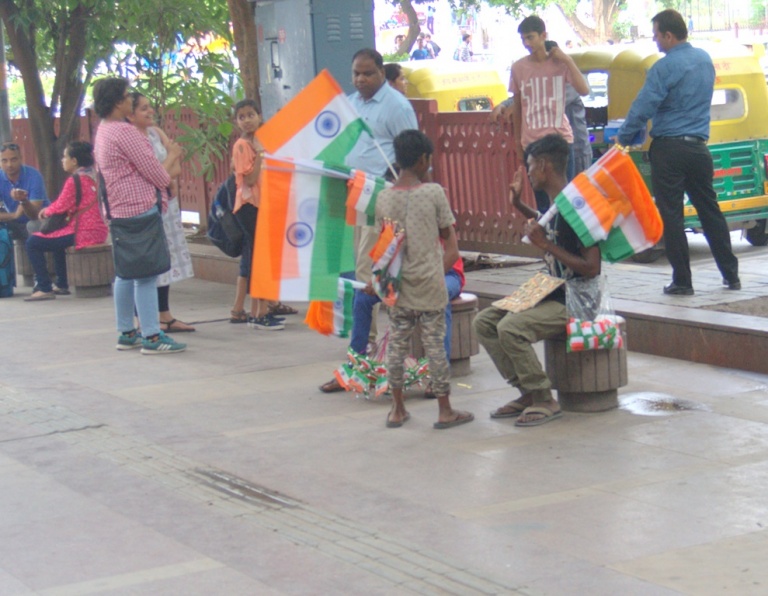EXPLORATION
Being a parent requires one to rethink their own childhood. As the author’s child wonders about the real meaning of freedom, she delves into her own childhood to look for a meaningful explanation.
Amrita Sastry is Assistant Professor, Department of Sociology, Jesus and Mary College, University of Delhi, New Delhi.
[dropcap]A[/dropcap]s I vividly remember my childhood memories, an average person, unschooled in philosophical reasoning, the celebration of Independence Day was just any other ‘National Holiday’ for me. Going to the school on 15th August for some time was part of a routinized ritual with flag hoisting by the school Principal, speeches by some teachers reminding us about our freedom fighters, followed by a patriotic song, then the singing of the national anthem followed by the distribution of sweets. Rest of the day I was ‘free’ to do what I wanted (not studying being one of the things) and thus cherishing the idea of ‘freedom’. Hence the idea of freedom not only in the context of Independence Day celebrations but otherwise also was absolutely misinterpreted and vague for me.

Why only for me, I can say this for many of my fellow classmates. The conceptual idea with which I grew up regarding freedom was independence of the ‘arbitrary will’. But this limited understanding about the notion of freedom changed over a period of time, and slowly it was clear that freedom enables a person to become responsible and creative in his/her own sphere. One cannot comprehend the idea of being free without having the other. And thus, freedom is just not the free will to choose from ample choices, but freedom is actually when one is above these choices- actual state of mind.
Recounting Freedom with My Seven Year Old
As I celebrate the spirit of Independent India, on this Independence Day I see my seven year old child in the same position as I was many years ago. Hence, I try to explain to him the idea of independent India and the idea of freedom by taking him out for a movie (primarily patriotic). Yet another national holiday, again I observe that the mundane idea of freedom still dominates our thinking pattern.
As I travel to the theatre on 15th August, at every traffic signal, I see children selling National Flags, stickers of National Flags, small replicas of national flags and people buying them as well.
While I entered the PVR cinema on Independence Day a different visual of ‘Patriotism’ was on display. The theatre was decorated with tri-colour balloons, the dress code of the staff was as per the tri-colour and ethnic, on their cheeks the tri-colour was painted, they were wearing tri-colour bands on their hands and the soft music played inside the lobby area and washroom was ‘Vande Mataram’. All these visual display had actually taken me back to the stadium and the world cup cricket match reminding of Emile Durkheim- his idea of ‘Totem’.
I was pretty sure all these attributes (sacred totemic symbols) associated with Independence Day and the idea of celebrating freedom was slowly engulfing my child’s thinking. He was sure by looking at the visual display that the possession of a National Flag or wearing a tri-colour T-shirt on 15th August was actually how one should celebrate Independence Day. I knew, as a sociologist, the roles of secondary agencies of socialization are very crucial role in shaping the child’s thinking and it was happening right in front of my eyes. While looking at my child, what was resonating in my mind again and again was, whether I have failed as a mother in imparting the correct values or since I couldn’t experience the struggle and sacrifices myself and got it ‘free’ without any effort, I have also failed to understand it completely.
Looking for Meaningful Alternatives to Rhetoric

The conflicting thought process churns my inner being and then I look for a meaningful alternative to explain to my child the real idea of freedom. Here, I am not talking about the literal or conceptual meaning of freedom, but freedom as a state of mind. I am hopeful that one day he will understand; hence I refuse to buy him the National flag. He questions and asks me if he doesn’t even have the ‘freedom’ to possess a National Flag on the day India got independence.

And it is here that I try to explain to him the ‘idea of freedom’. Freedom doesn’t mean reducing oneself to an atomised individual, freedom is not exercising one’s ‘arbitrary will’, and the celebration of the freedom struggle doesn’t necessarily mean the possession of a National flag. Rather freedom comes with certain duties and responsibilities, the real essence of freedom cannot be understood without respecting others.
Hence, I urge him to draw our National Flag instead of buying one and exercising his ‘free will’ to think and write about the idea of freedom. My hope slowly transforms into reality as I see him drawing the ‘National Flag’, India winning the gold medal in hockey in 1948 (after watching the movie GOLD) and then writing on ‘Freedom from greed’, ‘freedom from anger’, ‘freedom from lust’, ‘freedom from ego’, and ‘freedom from attachment. I know that he is too young to understand all these concepts but his freedom to think alternatively showed me the true spirit of freedom! Here I share two his creations where he expresses himself in the context of freedom.








